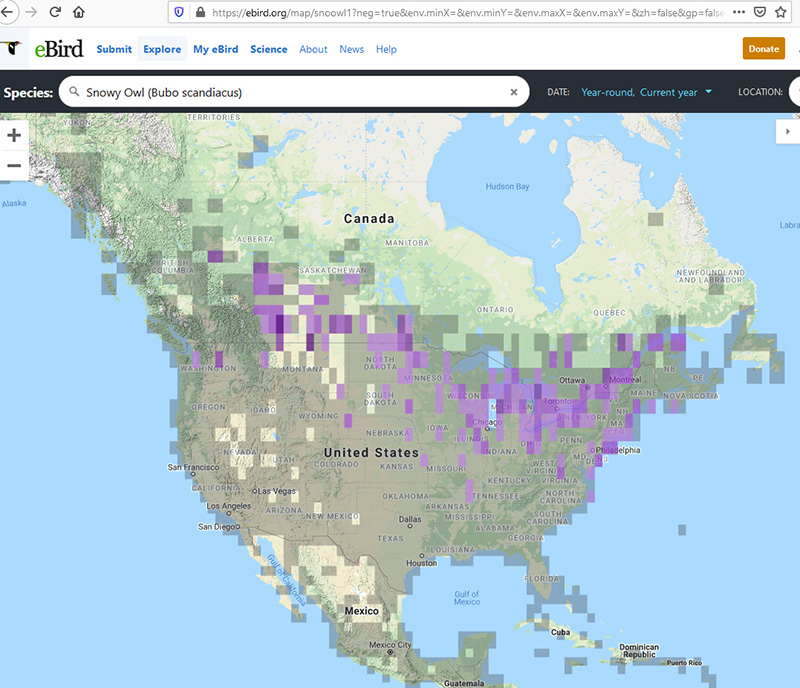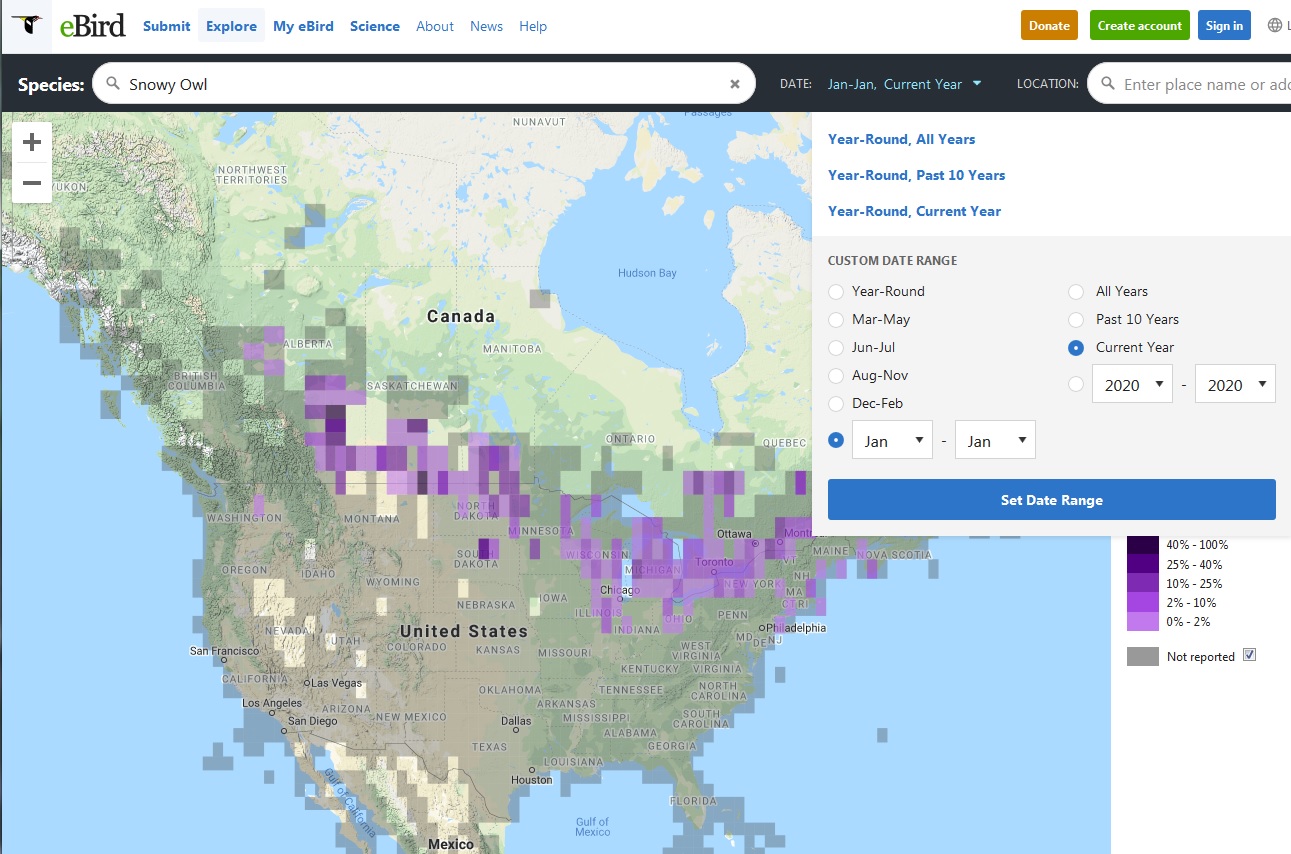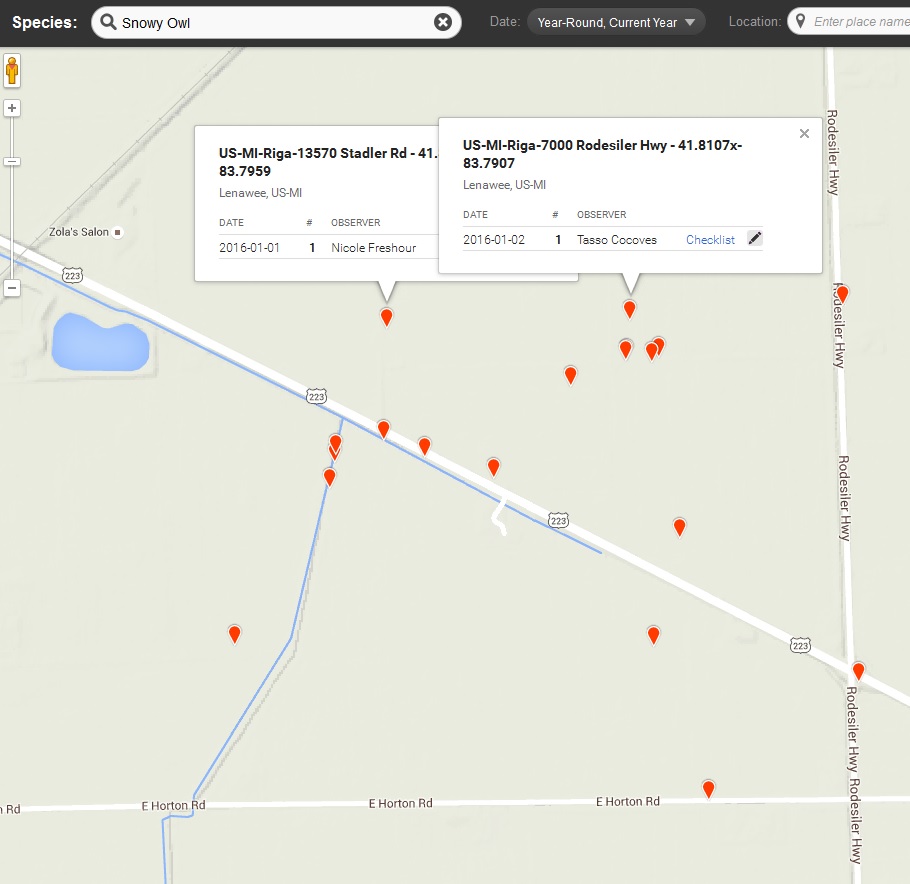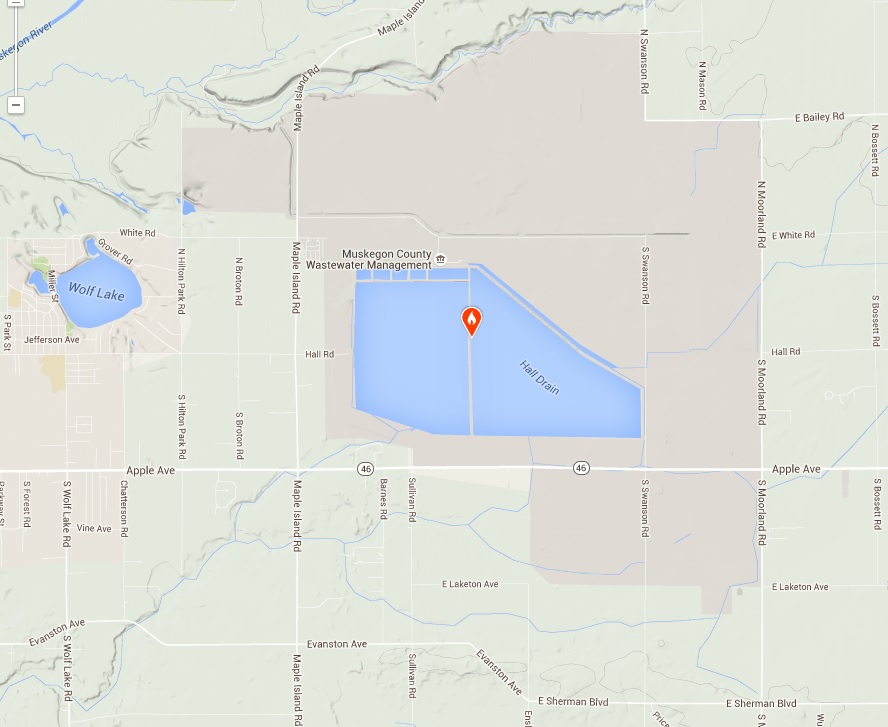Winter is your opportunity to photograph Snowy Owls. When it is cold enough and there is enough snow cover, snowy owls move down into the northern U.S. The colder it is the farther south they move. If conditions are right, don’t delay. If the winter turns warmer the snowy owls will head back north.
This is the first in a series of articles on Snowy Owl photography. Originally posted January 25, 2016. Revised and re-posted January 16, 2021. This article is also part of the Winter Photography Series.
FINDING SNOWY OWLS
To find snowy owls go to the Snowy Owl sighting map. You will need to create a free account at the eBird/Cornell Lab.
Use the drop down menu at the top of the map to set the map date for the current month of the “Current Year†to limit the map to recent sightings. If you want to find where the snowy owls are at right now, it won’t help you to look at old sightings.
If you are planning well ahead of your snowy owl expedition you can check past time periods to see what locations have snowy owls year after year. As the date arrives for your trip, check the most recent sightings.
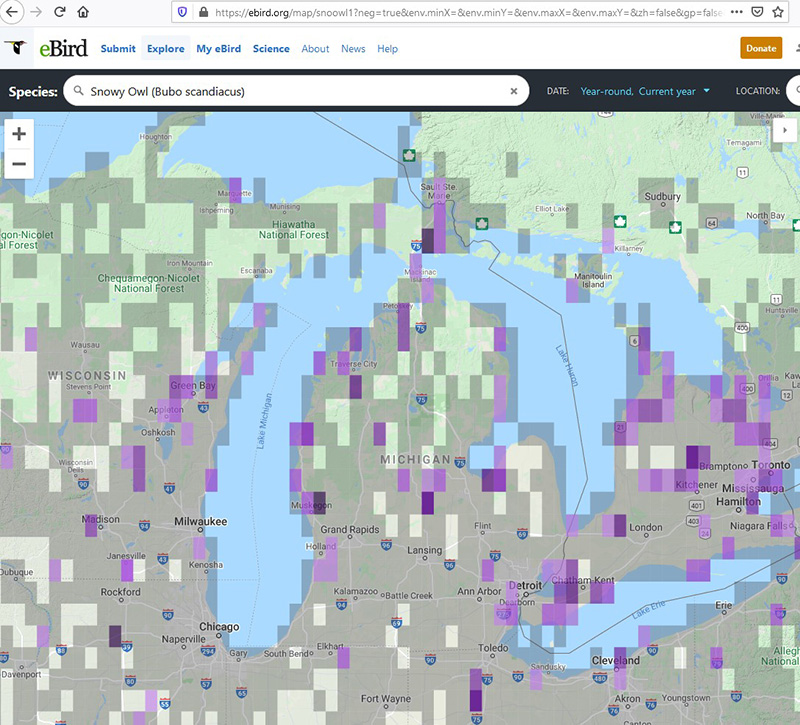
Pick an area on the map with purple colors. The more purple rectangles and the darker the purple the better. Use your mouse to grab the area you are interested in and drag it to the center of the map. Then use the plus (+) at the upper left of the map to zoom in.
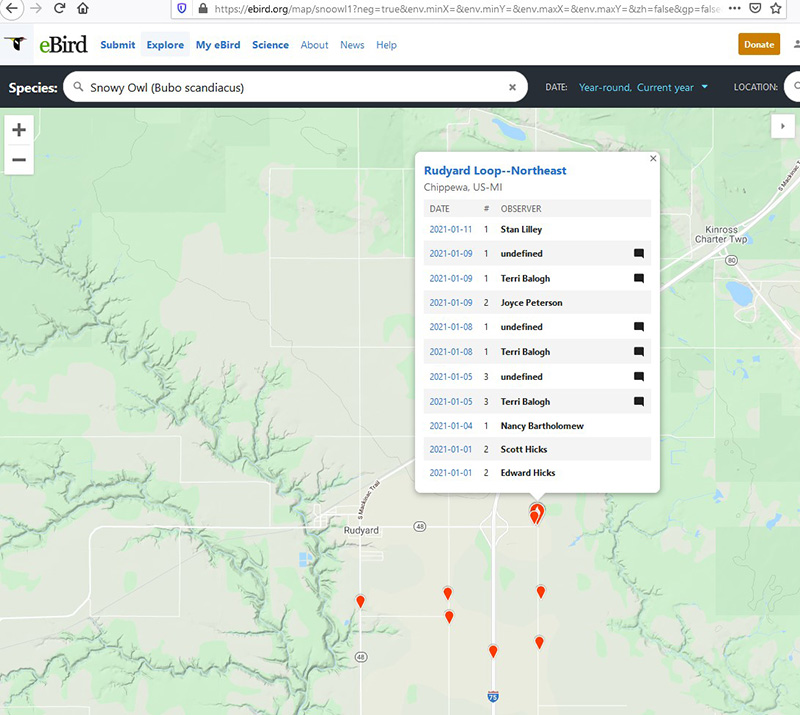
When you zoom in close enough the purple rectangles are replaced with red pins. Pick a target area that has a lot of red pins with recent sightings. The more red pins the better. Click on the red pins for details. This red pin shows a lot of sightings from January 1 right up to today (January 11, 2020).
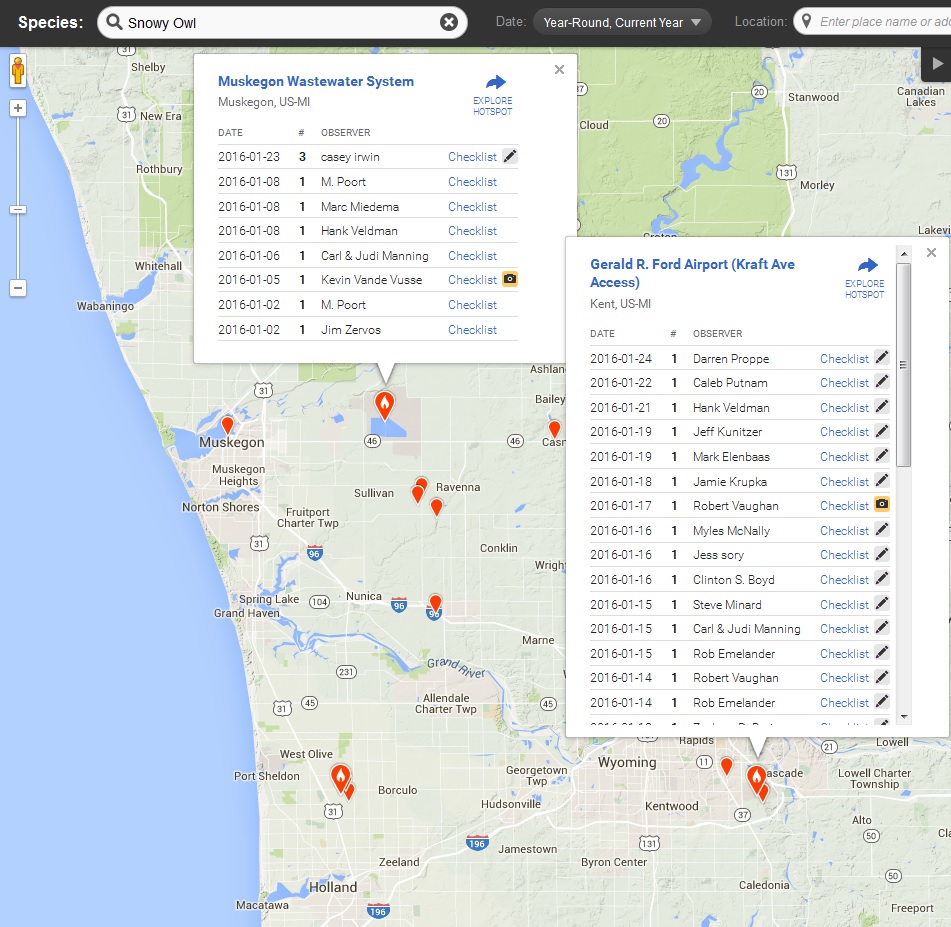
This map from the Grand Rapids-Muskegon area in Michigan. You can open up more than one red pin. If you click on several red pins and don’t find any sightings for the last two or three days the snowy owl or owls have moved on. Zoom back out and find another purple area.
On this map I found a bunch of sightings clustered in an area east of Adrian Michigan, but they were all much too old for the date I checked the map (Jan. 25, 2016). It was way too late to go there.
Once you have picked a good target area, look for more target areas in the same state or part of a state. You want several options. It is not unusual to arrive at a target area only to discover the owl that was there the day before your trip is not there on the day you arrive. So you need several options.
Save a screen capture of the location maps for all of your target areas to your laptop or smart phone so you can find the locations when you get there. Or print the location maps on your computer and take them with you. You may not have internet access at your target area so be prepared.
When you arrive at your first target area, drive the roads where there were sightings and all of the other nearby roads in the area. If you don’t find any snowy owls go to your next target area. If none of your target areas work out, you may need to go back online and check the Snow Owl sighting map again to pick new target areas.
For more detailed suggestions on finding (and photographing) snowy owls, read A Snowy Owl Photo Expedition.
PHOTOGRAPHING SNOWY OWLS
Exposure Tips
A white bird against a snowy white background is a recipe for underexposure if your camera is in auto exposure mode. With a white subject and a white background, some “plus exposure compensation” is in order. Set your camera’s exposure compensation scale somewhere between +1 and +2. A white bird against a dark background is even trickier for auto exposure with the risk of a seriously overexposed bird. Best to switch to manual mode and meter an 18% gray card, a neutral toned subject, or use an incident light meter.
These articles go into more detail:
Metering Wildlife in the Snow, Part One
Metering Wildlife in the Snow, Part Two
Approaching Snowy Owls
Have your camera and lens ready to go on the car seat beside you. Set the metering in advance to the existing conditions. If the light changes, pick some snow and re-meter. Stay in your car. When you spot an owl, slow down, turn off your radio, and roll down the window you will be shooting out of. Take your time driving slowly up to the owl. Watch the owl. If it gets nervous, stop and wait. No sudden movements. When the owl calms down, slowly pick up your camera and take a picture. Then drive a little closer. Every bird is different. Some will allow you to get closer than others. When you are as close as you can get with your car, make the most of it and take enough pictures so you are sure you have the best possible shot. Only then should you think about getting out of your car to approach the owl on foot.
Read this article for advice on approaching an owl on foot.
Equipment
Long lenses are the rule for photographing birds. 300-400mm or longer are preferred (35mm equivalent focal length). If you don’t want to break the bank on a 300, 400, or 500mm prime (single focal length) lens, look at the 100-300mm, 100-400mm, 55-250mm and similar telephoto zoom lenses lenses that are available. Some of the superzoom point and shoot cameras have lenses that zoom out to 500mm and longer (35mm equivalent).
The Snowy Owl Series
“How To†Series: Snowy Owl Photography – An Overview
eBird Link
Snowy Owl sighting map at eBird.org
The Snow Owl Series is also part of the Winter Photography Series.
The Winter Photography Series
“How To†Series: Winter Photography – An Overview with article links
Winter Related Links
The Best National Parks to Photograph in Winter
One Photographer and Nine Outdoor/Travel Writers Pick the Best Winter National Parks
More Links
How To Find Wildlife, The Best Books
How To Photograph Wildlife, The Best Books
How to Be A Better Wildlife (and Nature) Photographer
How to Use Your Camera’s Exposure Compensation Scale
Great Gray Owl at Whitefish Point
Why Is Exposure So Important? The first in a series of articles covering the basics of exposure with links to the rest of the articles.
If you want to master exposure, read Digital Photography Exposure for Dummies, one of the highest rated photography books at Amazon.com. It covers basic, intermediate and advanced exposure techniques all in one book so you won’t need to buy another book on exposure as your skills advance. It also introduces you to wildlife, landscape, flower photography, people, portraits, and event photography, plus closeup and low light photography. Learn more here and order it at Amazon.com.

